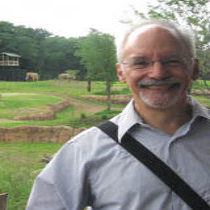Landscape Architecture for Landscape Architects › Forums › SUSTAINABILITY & DESIGN › Wildlife Crossing: Good idea?
- This topic has 1 reply, 12 voices, and was last updated 13 years, 4 months ago by
 Phil Moorehead.
Phil Moorehead.
-
AuthorPosts
-
July 26, 2012 at 4:20 pm #156867
 Andrew SpieringParticipantJuly 26, 2012 at 6:32 pm #156879
Andrew SpieringParticipantJuly 26, 2012 at 6:32 pm #156879 Phil MooreheadParticipant
Phil MooreheadParticipantI have to wonder how effective they are.
An animal would need to…
A: Recognize a freeway as a mortal threat.
B: Recognize the wildlife bridge as a safe alternative.
C: Be able to locate a wildlife bridge.
Deer, raccoon, coyote, mountain lion, etc… I’m pretty sure most large mammals would cross a freeway wherever they came upon one (especially deer). If there were some way to corral smaller mammals, amphibians and reptiles by creating a barrier along the freeway edge that opened to the bridge, that would probably make it somewhat effective as a wildlife corridor for them, at least. Maybe you could somehow bait the other animals? Something like this would only work if it were part of a very large and very expensive system. If you had one every mile and were able to train wild animals to use them and create game trails across them, then yes, they would probably work.
Perhaps a subgrade crossing would be less expensive? You could lay a pipe under the freeway, which I believe has been done before, or you could create a moderately sized trench (15′ x 15′?) which the freeway could span with a much smaller bridge than the one shown above. This would allow some daylight/moonlight to penetrate and possibly create an intermittent stream. Since animals naturally use waterways as corridors already, it might be more enticing.
July 26, 2012 at 7:37 pm #156878 ncaParticipant
ncaParticipantIt would take time, not overnight, but I think the idea is generally that you place these crossings to align with natural wildlife migration corridors. Larger wildlife like elk as I understand dont deviate too far from historic routes.
Good idea, with lots of potential beyond just wildlife..
The alternative is long lines of fencing, forcing wildlife off their natural migration corridor. We have lots of that here on local highways. Seems like it leads to ‘bottle-necks’ of busy and dangerous crossings. This idea combined with fencing or some other directing device seems to make sense.
July 26, 2012 at 8:00 pm #156877 Trace OneParticipant
Trace OneParticipantThis is a good idea, that one is gorgeous, but there are a lot of ‘mitigation measures’ that to me are just bandaids for the displacement of wildlife – like providing llittle holes in concrete highway barriers to let the kit fox get through (right!), or timing a project for when bats aren’t nesting, then providing bat boxes when the project is done – right again, pull the other one, I think. The CEQR process provides almost no opportunity to say no, it only provides for ‘mitigation measures.’ I think the weakness in our environmental laws is apparent in that we are already looking at allowing BP to lease land for drilling in the arctic, fast on the heels of the disaster of negligence in the Gulf BP oil spill.
It’s just a joke. We are experiencing the ‘sixth great die-off’, the extinction of species as a ceaseless drumbeat to human expansion, and we can’t come up with any way to stop it..
I have long thought that we could work with smells, to keep animals off highways and train tracks..Just a thought..
July 31, 2012 at 1:42 am #156876 Emily StruthersParticipant
Emily StruthersParticipantPerhaps–that is, if the ‘wildlife bridge’ served to fill more than just a gap in space. What I’m saying here, is that on each side of the bridge you have some pretty established vegetation, it would help for there to be some sort of continuity between the existing ‘wildlife’ and the engineered bridge. This would encourage squirrels, birds, insects, and other smaller animals to cross this bridge and form a more complete system.
But then again, that all also depends on what sort of habitats we are working with.
And, on the other hand, it’d be expensive, there would be maintenance, tunnels can be dangerous and slow down traffic.
But, I’m an optimist as long as you can find some funding.
July 31, 2012 at 4:09 pm #156875 Rob HalpernParticipant
Rob HalpernParticipantI believe that, in general, wildlife crossings work better as underpasses than as overpasses. Depends. The design that works for elk would not be used by Florida panther (yes, they are not in the same region…but designs are not interchangeable)
The natural behaviors of the wildlife in question need to be studied and a crossing designed to exploit their behavior.
This example seems to be one designed by a road planner or a land use planner rather than by biologists.
This is rather interesting: http://www.wildlandscpr.org/node/220
August 1, 2012 at 9:43 am #156874mark foster
ParticipantI talked with a naturalist (in Georgia?) about the wildlife tunnels they installed under the freeways. She said the biggest unintended consequence was the predators hang out there–kind of a modern day watering hole affect.
August 1, 2012 at 11:26 am #156873 Andrew Garulay, RLAParticipant
Andrew Garulay, RLAParticipantAs with any good design, when the specific criteria needed to make it function is matched with the site it will be good. When a concept is imposed uniformly it becomes a box of chocolates as Forest Gump’s momma would say.
Some animals need this more than others and some highways need this more than others. Where there is density of large mamals crossing the highway in herds, there is more often a smaller population and less traffic volume where the crossing is more likely for human safety than that of the animals.
Where human population is higher and traffic is as well, the conflict between bigger animals and people is less about a species in trouble than it is simply the preservation of individual animals because it is very rare that larger animals are in such areas unless their populations are generally high in the first place.
These are a good idea in existing migration corridors (animals of any size) and less necessary in general wildlife areas I would think.
August 1, 2012 at 2:06 pm #156872 Trace OneParticipantAugust 1, 2012 at 5:17 pm #156871
Trace OneParticipantAugust 1, 2012 at 5:17 pm #156871 Tosh KParticipant
Tosh KParticipantThese always remind of the West Wing episode with the wolf highway lobbyist… I know they work for some species, but as mark pointed out can lead to kill zones (which I suppose means the prey are using them…). One would think that the traffic safety factor for larger critters makes it more economically prudent to fund them. Here’s to hoping these add some projects to our profession’s pipeline.
August 2, 2012 at 3:21 am #156870 BoilerplaterParticipant
BoilerplaterParticipantThe NJDOT had a couple of these along I-80 (I think). From what I heard anecdotally from their wildlife people, they are quite effective. Of course the highway is fenced for miles in each direction there. From the highway, they look like just another overpass, but with extra-thick (7′ tall!) beams that they placed a lot of fill on. It was just seeded and native species were allowed to colonize. They are fairly heavily treed. Dear-car accidents are a major problem in New Jersey, and you often see deer standing on the side of roads in apparent consideration of crossing, so they do seem to recognize a threat.
Google “ecoducts” if you want to see more of the small pipe-type crossings you are talking about that are used in other countries. I think the Brits call them ecoducts.
August 3, 2012 at 5:51 am #156869 Les BallardParticipant
Les BallardParticipanthtt://en.wikipedia.org/wiki/Wildlife_crossing
http://www.wildlandscpr.org/evaluation-wildlife-crossing-structures-their-use-and-effectiveness
http://www.badgerland.co.uk/help/helpbadgers/tunnels.html
http://www.youtube.com/watch?v=Qi-9ycF45YE
http://uktv.co.uk/blighty/stepbystep/aid/600114
I hope these links assist and it will be seen that tunnels, etc. are well known, appreciated and used and costs can be light or included in such building contracts as the new high speed rail line from London to Ashford and the Channel Tunnel.
August 3, 2012 at 1:30 pm #156868Michael A. Hill
ParticipantWildlife corridors can provide not just improved access to habitat but ways for people to interact safely with wildlife in ways that don’t disrupt animal communities.
While admitting that the efficacy of these structures needs more study, the Federal Highway Administration thought enough of the idea to develop a design guide in 2011. There’s lots of examples of multiple local and federal agencies teaming up to provide corridors across multiple public lands. According to this article from February 2012 Utah Standard-Examiner, a primary reason the state builds them is to avoid deaths of people that hit or swerve to avoid animals on their roads. The article also shows some video of wildlife captured by cameras in the tunnel — which means the corridors also have the potential to be of benefit to wildlife biologists studying vulnerable animal populations.
The real question in my opinion, is does the corridor need to be a high-design item to be effective? The image above shows a structure that is a lot more expensive that the simple tunnel shown in the article sited earlier, and if it simple — and cheaper — you can potentially build more of them and have a bigger impact on animal preservation.
Ultimately, are these structures just for the animals, or are they for us as well? And if so, Are they the responsibility of designers or wildlife biologists and engineers? What do you think?
-
AuthorPosts
- You must be logged in to reply to this topic.



